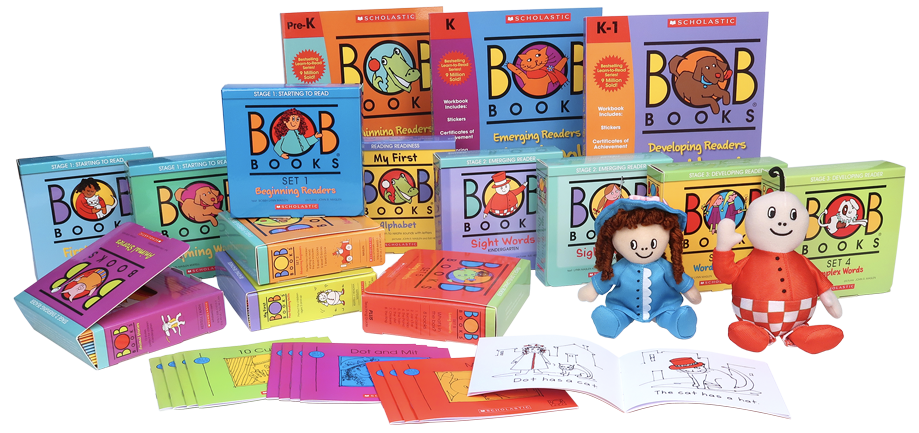Beholden to Bob Books
Bob Books, How do I love thee? Let me count the ways….
📕 You’re adorable at just 4”x5” with cute color blocking and simple drawings
📘 You’re sequential
📗 You progress at a tangible pace
📙 Your stories are entertaining, sometimes silly, and ever-so-satisfying
📚 You make the monumental manageable, with easy steps to lead new readers up the ladder to launch their reading rockets 🚀
If you have a little one setting forth into the realm of reading, I cannot recommend the Bob Books Series by Bobby Lynn Maslen & John R. Maslen more highly.
Have you seen them? For one thing, how cute are these color-blocked 4”x5” little booklets? :) Their simple line drawings make the stick figures artist in me know that even I can have hopes to be included in illustratrated books one day! ;)
More to the point, these books follow a phenomenal progression of phoneme blending unlike any other set of books I’ve found to date. From their series for pre-readers to learn letters with “Reading Readiness” sets; moving into beginning readers with brief stories, rhymes, and CVC words in “Stage 1: Starting to Read” books; then growing in complexity with “Stage 2: Emerging Readers” with more sight words and longer passages; and then landing on “Stage 3: Developing Reader” with complex vowel patterns, words families, and long vowel focus. They are a great launching pad for young readers to get their footing before taking off into the realms of chapter books, nonfiction, poetry, and all the expansive world of words offered.
Progression:
There is a baffling trend for children’s books to slap on a “Beginning Reader” or “Level 1” label that, to my trained eye, can only be explained by the low word count in the text. They introduce numerous, complex sight words and a range of vowel sounds which in no way are easy for beginning readers. It’s like trying to quench one's thirst with a fire hose instead of a simple juice box straw.
Simplicity and consistency make Bob Books a dependable way of perfecting mechanical reading skills and increasing comprehension. They start out with essential skills and build on them sequentially. In Stage 1, each book focuses on a short vowel. I bet you can guess which vowels are introduced, just by looking at the titles:
Mat, Sam, Dot, Mac, Dot and Mit, Dot and the Dog, Jig and Mag,Muff and Ruff, 10 Cut-ups, Peg and Ted, Lad and the Fat Cat, The Vet.
As you can see, even in the title, these stories focus on CVC (Consonant- vowel- consonant) words, the basic building blocks of decoding words, starting with short /a/. Moving forward, the short /a/ practice is reinforced, then short /o/ is introduced with short /a/ as its companion. The books continue in this spiraling manner, looping in a new vowel friend while circling back to be sure the prior one is secured. This also allows for more varied stories, as more words are now available.
The passages have brief sentence structures and do a wonderful job weaving together a narrative constructed from such limited vocabulary, with simple yet sweet illustrations to enhance the storyline. The text is highly decodable, using a direct sound/letter correlation, with minimal sight word introduction at the outset.
The stories then build at a very reasonable pace, slowly introducing new vowels before lengthening sentences and delving into complex vowel patterns.
Once your child is familiarized with short vowels, Bob Books have other series to provide practice with an assortment of all short vowels (Bob Books Set 2), followed by a natural progression into rhyming word families, more complex words, and finally long vowels.
What I love about Bob Books is knowing that once a child has mastered a book, the natural progression is to go on to the next book in the series where the child will be given a new concept to incorporate into the framework that was built before it.
Thank you, Bob Books, for this gift of a reading ladder to help launch our young readers into the wonderful world of literacy, to infinity and beyond!
Your fan,
With Joy,
Amy

